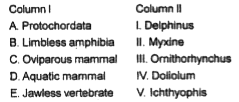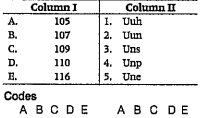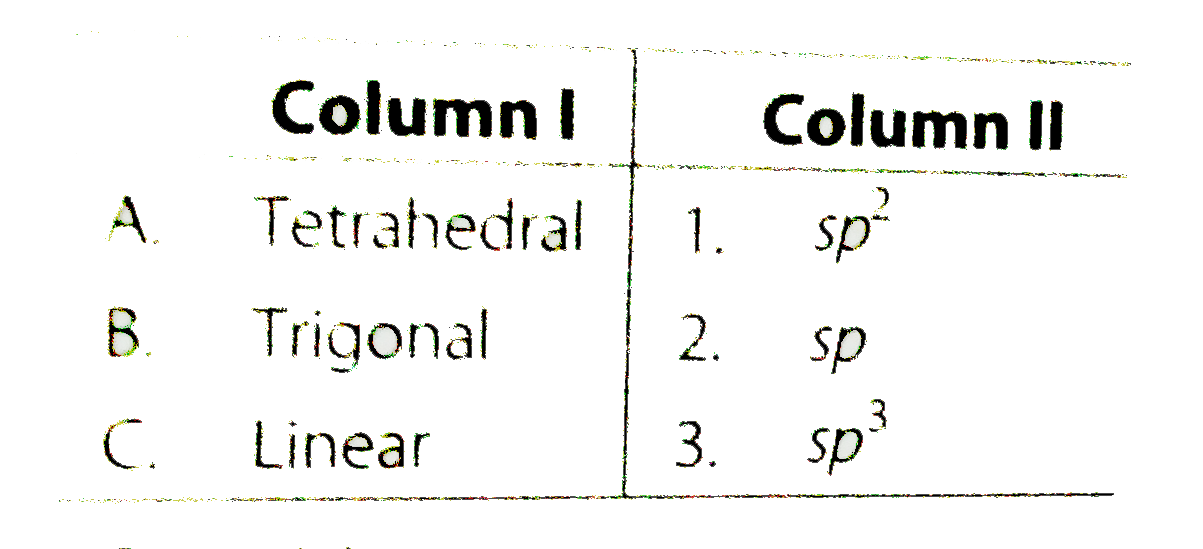Match the items in Column I with relevant items in Column II
Column IColumn II(i) Ions having positive charge(a)+7(ii) The sum of oxidation number of (b)−1 all atoms in a neutral molecule(iii) Oxidation number of hydrogen (c)+1 ion(H+)(iv) Oxidation number of fluorine in (d)0 NaF(v) Ions having negative charge (e) Cation(f) Anion
(i)→(e),(ii)→(d),(iii)→(c),(iv)→(b),(v)→(f)
Topper's Solved these Questions
- REDOX REACTIONS Book:PRADEEPChapter:REDOX REACTIONS Exercise:Long Answer Question
Explore 8 Videos
- REDOX REACTIONS Book:PRADEEPChapter:REDOX REACTIONS Exercise:Very Short Answer Question
Explore 21 Videos
- REDOX REACTIONS Book:PRADEEPChapter:REDOX REACTIONS Exercise:NCERT(EXEMPLAR PROBLEMS WITH ANSERS HINTS AND SOLUTION-II)
Explore 5 Videos
- POLYMERSBook:PRADEEPChapter:POLYMERSExercise:IMPORTANT Questions (For Board Examination)
Explore 27 Videos
- SOLUTIONSBook:PRADEEPChapter:SOLUTIONSExercise:IMPORTANT QUESTIONS FOR BOARD EXAMINATION
Explore 31 Videos
Similar Questions
Match the items in Column I with relevant items in Column II
Column IColumn II(i) Ions having positive charge(a)+7(ii) The sum of oxidation number of (b)−1 all atoms in a neutral molecule(iii) Oxidation number of hydrogen (c)+1 ion(H+)(iv) Oxidation number of fluorine in (d)0 NaF(v) Ions having negative charge (e) Cation(f) Anion
View SolutionMatch the items in Column I with relevant items in Column II
Column IColumn II(i) Ions having positive charge(a)+7(ii) The sum of oxidation number of (b)−1 all atoms in a neutral molecule(iii) Oxidation number of hydrogen (c)+1 ion(H+)(iv) Oxidation number of fluorine in (d)0 NaF(v) Ions having negative charge (e) Cation(f) Anion
View Solution
Knowledge Check
Match item in column I with those given in column II. Column 1
 AA-V, B-IV, C-III, D-I, E-IIBA-IV, B-V, C-II, D-I, E-IICA-IV, B-V, C-III, D-II, E-IDA-V, B-III, C-I, D-II, E-IV
AA-V, B-IV, C-III, D-I, E-IIBA-IV, B-V, C-II, D-I, E-IICA-IV, B-V, C-III, D-II, E-IDA-V, B-III, C-I, D-II, E-IVMatch the items in Column I with its main use listed in Column II:
Column I Column II(A) Silica gel(i) Transistor(B) Silicon(ii) Ion-exchanger(C) Silicone(iii) Drying agent(D) Silicate(iv) SealantA(A)-(iii),(B)-(i),(C )-(iv),(D)-(ii)B(A)-(iv),(B)-(i),(C )-(ii),(D)-(iii)C(A)-(ii),(B)-(i),(C )-(iv),(D)-(iii)D(A)-(ii),(B)-(iv),(C )-(i),(D)-(iii)
Match the atomic number in column I with its IUPAC nomenclature in column II

View SolutionMatch the half reaction in column I with change in oxidation number in column II

View SolutionMatch the items given in Column I with examples given in Column II.

View SolutionMatch the items given in Column 1 with examples give in Column II.
Column IColumn II(a)Hydrogen bond(i)C(b)Resonance(ii)LiF(c)Ionic solid(iii)H2(d)Covalent solid(iv)HF(v)O3
View SolutionMatch the shape of molecules in Column I with the type of hybridisation in Column II.

View SolutionMatch the items given in column I with appropriate items (o ne or more) of column II :
Column I Column II(i) m- RNA (a) UAA(ii) Initition condon (b) Beadle and Tatum(iii) Termination codon(c) AUG(iv) Anticodon(d) Hetergoeneous nuclear RNA (hn RNA)(v) One gene one enzyme hypothesis(e) GUG(vi) Semiconservative mode of DNA replication(f) UAG(g) t-RNA(h) Meselson and Stahl
View Solution

